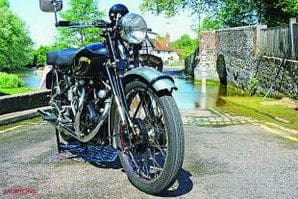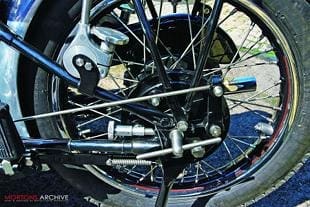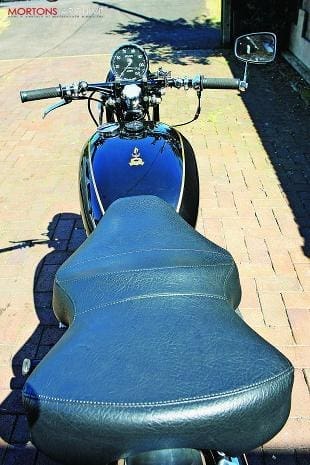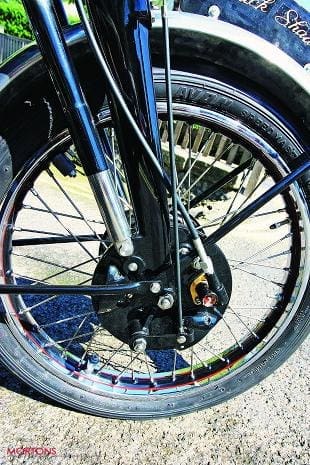
Vincent’s Black Shadow has been reborn. This is nothing to do with a vague outline by a company with no clear claim to use the Vincent name, promising to offer the world a Honda-powered 21st century version of a bike that needs no such travesty to keep its name alive. This is a newly built replica of a 1952 Shadow, put together by a man with very high Vincent building skills, using parts supplied by the Vincent Spares Company and financed by the Vincent Owners’ Club. This bike is totally kosher; this bike is what was once a pipe dream, now come true.
Anyone unfamiliar with the standing of the Vincent HRD motorcycle in motorcycling’s history might wonder why anyone would want to build such a bike. After all, production at the famous Stevenage factory came to an end in 1956, so why bother to build one in 2007? Because this is probably the most iconic of British motorcycles, that outranks names like Brough Superior, BSA, Norton or Triumph in its reputation for quality of build and sheer performance.
 The Black Shadow was introduced in 1948, a development of the 998cc Rapide twin, and Motor Cycling tested it at 122mph. We have to bear in mind that at that time, the only fuel available for road bikes was the 72-octane ‘Pool’, a close relative to paraffin with a sniff of the barmaid’s apron for a boost; that diet dictated a compression ratio of just 7.3 to 1.
The Black Shadow was introduced in 1948, a development of the 998cc Rapide twin, and Motor Cycling tested it at 122mph. We have to bear in mind that at that time, the only fuel available for road bikes was the 72-octane ‘Pool’, a close relative to paraffin with a sniff of the barmaid’s apron for a boost; that diet dictated a compression ratio of just 7.3 to 1.
In a world where most traffic moved at 40 to 50mph, and 500cc motorcycles and their top speeds of 80mph were the fastest, a motorcycle capable of a good 120 was the stuff of dreams. Ariel’s 997cc Square Four was developed to offer a genuine 100mph maximum, and parallel twins from BSA and Triumph were good for close to that magic figure, but Vincent’s top twin smashed all perceptions of road machine performance. It was the sort of performance lasting legends are made of.
The long term support to keep those legends in good working order and out on the roads of the world is realised through the Vincent Spares Company, based in Lymm in Cheshire, and quite independent of the Owners’ Club in its operation. There is, of course, co-operation and liaison between the two bodies, but the Spares Company is expected to stand on its own two feet financially and help to keep the wheels turning. Full credit should be given at this early stage to David Meadowcroft and his determination to make the service live up to the bike’s reputation.
Engine and gearbox
David proved a point when a new engine and gearbox unit was built in 2005, to show the range and quality of the components available. After that, what was there left to do? A complete bike, of course, but that meant producing the complex oil carrying main frame member, main blades for the unique Vincent ‘Girdraulic’ forks, the forged steering gear lug and the top links for the forks. And there was no question of casting around for a substitute to get the job done quickly: “There are lots of parts we could have modified, but we didn’t take that route,” explained club information officer Paul Adams. “We wanted the parts to be interchangeable with the original stuff.
“Everyone in the club was enthusiastic when we put the idea before them and we started early in 2006, with a deadline of one year to complete the job.” Assembly was the job of Glyn Johnson, who has restored a number of Vincents for the National Motor Museum and did such a good job on the 1950 works TT bike that it was voted Classic Motorcycle of the Year at Stafford. Clearly, no mug when it comes to Vincents, and he’s one of a handful of assemblers really competent to build a machine from parts if you’re looking to have a brand new Rapide or Shadow of your own.
 At the spares company, the problem of the few unavailable parts was addressed, co-operating with the club’s technical committee. “There was a huge amount of time redrawing parts and uprating the specifications,” Paul Adams recalled. “We have computer aided design people on the committee, along with metallurgists and the like. They’re all engineers with a strong Vincent background.” They faced a huge task, with a schedule of one year to build the bike, and that included production of the parts that had long been on the Unobtainium list. It speaks volumes for the effort and efficiency of the operation that the first new Black Shadow since 1956 was finished at the beginning of the year.
At the spares company, the problem of the few unavailable parts was addressed, co-operating with the club’s technical committee. “There was a huge amount of time redrawing parts and uprating the specifications,” Paul Adams recalled. “We have computer aided design people on the committee, along with metallurgists and the like. They’re all engineers with a strong Vincent background.” They faced a huge task, with a schedule of one year to build the bike, and that included production of the parts that had long been on the Unobtainium list. It speaks volumes for the effort and efficiency of the operation that the first new Black Shadow since 1956 was finished at the beginning of the year.
The work of the Spares Company is worth a feature in itself, but the hot news this month is that we have ridden the living, deep breathing proof that anyone with the funds can have a new Vincent built. Paul Adams said it would be available to ride from the first day of May and on the second day CBG was in Kent, ready to go. Paul had put 280 miles on the bike, so it was still in the early running-in stages: “That means don’t work it hard or let it slog, just ride it along lightly and with enough room it’ll get up to 65 or 70 miles an hour with no effort at all,” he explained.
Proud and impressed
Also there was Dick Wheeldon, the club’s liaison officer with the Spares Company and a director of the company, who’s proud and impressed at the way it has moved forward since David Meadowcroft was appointed managing director five years ago and addressed the matters of quality control and availability. It’s now recognised as the most comprehensive source of Vincent parts in the world, and supplies specialists all over the globe.
Building a replica of the outstanding road bike of 1952 is quite a task in itself, but when it came to registering it on the road another cycle of complication began, as it had to pass all tests to prove that it complied with 2007 specifications and legislation. At that point, you wouldn’t have blamed Paul Adams if he’d resigned his position and ridden off into the sunset on his own much modified Shadow, never to bother with paperwork again. But the man is made of sterner stuff than that, and the new Shadow was finally issued with an 07 registration number after a long succession of tests and paperwork processes. It had to be fitted with winkers for one test, but they seem to have disappeared since then….Oh Lordy, don’t you really admire the current capacity to provide work for people for no obvious benefit to anyone?
 The bike does vary slightly from original specification. The Amal carburettors are 1 and 1/16th inch choke size, instead of the 1 and 1/8th of the Black Shadow when it left the factory, but the club has been promised production of the larger size this year and they’ll be fitted as soon as they’re available. And as Mr Miller is no longer making the 60 watt dynamos the factory fitted, this one wears a French-made Alton alternator that looks like a traditional British dynamo and puts out a very non traditional British 200 or so watts. That means the lucky new owner will be able to ride his or her bike with the headlights on and not fear for the battery.
The bike does vary slightly from original specification. The Amal carburettors are 1 and 1/16th inch choke size, instead of the 1 and 1/8th of the Black Shadow when it left the factory, but the club has been promised production of the larger size this year and they’ll be fitted as soon as they’re available. And as Mr Miller is no longer making the 60 watt dynamos the factory fitted, this one wears a French-made Alton alternator that looks like a traditional British dynamo and puts out a very non traditional British 200 or so watts. That means the lucky new owner will be able to ride his or her bike with the headlights on and not fear for the battery.
Paul kicked the bike into life and the first impression was the lack of the mechanical noise that was an accepted accompaniment to the all alloy engine of the original bikes. Modern machining tolerances and better quality castings have hushed the noise enough to comply with whatever EU regulation motorcycles have to comply with today. How that distinctive and deeply basso profundo exhaust note got past the regulations is a mystery to me; I suspect that there’s more enthusiasm for recognising fine British engineering than there is for form filling somewhere in the heart of bureaucracy.
 The bike was at the foot of Paul’s steep drive, and memories of the two distinct stages of clutch take-up had me worried; as I recall it, there was the initial bite and then the engagement of the servo drum clutch that put the real power through to the heavy Vincent made gearbox. That used to foil novices, and many’s the twin that has stalled to the embarrassment of its rider, while the experienced Vincent men stood around and shared a quiet grin. Determined to avoid such humiliation, I gave the engine a little gun and fed the progressive clutch in, to drive up the steep rise and stop at the roadside; only later did Paul and Dick explain that this bike has a multi-plate clutch with progressive action.
The bike was at the foot of Paul’s steep drive, and memories of the two distinct stages of clutch take-up had me worried; as I recall it, there was the initial bite and then the engagement of the servo drum clutch that put the real power through to the heavy Vincent made gearbox. That used to foil novices, and many’s the twin that has stalled to the embarrassment of its rider, while the experienced Vincent men stood around and shared a quiet grin. Determined to avoid such humiliation, I gave the engine a little gun and fed the progressive clutch in, to drive up the steep rise and stop at the roadside; only later did Paul and Dick explain that this bike has a multi-plate clutch with progressive action.
The first few yards were punctuated by a front wheel wobble that cleared as the speed rose above 10 or so mph. The gearchange from first to second was early and smooth, the motor pulling strongly as the speedo needle rose to 30. Ah yes, that speedo. It’s the legendary five inch diameter (look, this is a British Vincent, and if you think I’m going to translate that measurement into millieurowhatsits, you’re seriously mistaken) dial that sits centrally and leaves the rider with no lame excuse like `Sorry officer, I didn’t realise I was doing that speed’. The response will be: “Can’t see that dial, Sir? Shall we drive to the station for an eyesight check?” and your cover will be blown. So through the 30mph limit the Vincent murmured quietly in second gear, impatient to get on with the business of getting on.
I followed Dick Wheeldon on his Series D `Black Knight’ through the Kent countryside as a succession of lanes crossed the intrusive vastness of the M25. Into third at 40mph, then fourth (and top) at around 50. In between this good experience we had to stop for the matter of photographs, but that’s nothing to do with the experience of riding this bike – a brand new Black Shadow. After all these years, the dreams of youth were being realised and I was on a new example of 1952 Britain’s (and the world’s) Fastest Road Motorcycle.
Inevitable tightness
Down bumpy lanes the newness and inevitable tightness of the suspension units was evident and transmitted through the shaped dual seat that gave grip to the rear end but strictly dictated the riding position; none of your undignified, fancy racing crouches on this seat unless you’re prepared to put a very personal matter at some risk. This is not a light bike by 1950s British standards at 455lb but it’s a medium weight today, and leaned into corners with little effort in pursuit of Dick Wheeldon’s smooth progress over roads he clearly knew well. The brakes, twin drums up front and one at the rear, were progressive with plenty of bite; you can see why Vincents were consistently the best in road test braking figures.
 Much of the riding experience, close to 50 miles of it, was on roads that few people would regard as a Vincent twin’s natural habitat, but it sat on the road and did the job without effort, even if low speed riding was not as easy as a smaller bike; just what you’d expect in fact. Then a long, winding stretch of lane saw the speedo nudge up towards 60mph and the bike was transformed.
Much of the riding experience, close to 50 miles of it, was on roads that few people would regard as a Vincent twin’s natural habitat, but it sat on the road and did the job without effort, even if low speed riding was not as easy as a smaller bike; just what you’d expect in fact. Then a long, winding stretch of lane saw the speedo nudge up towards 60mph and the bike was transformed.
Harmony of movement
Everything about its operation combined in a harmony of movement that reminded me this is a machine designed and built to get on with the matter of long distance travel; it came alive and felt like a friend who’d taken my hand and said ‘This is how it should be’. The deception was complete; I felt like I was doing 45mph or thereabouts and the big black and white speedo dial was showing a shade more than 60 as that glorious big vee-twin shrugged off the tedium of low speed and showed what it wanted to do.
The only fault to emerge was a first gear engagement that baulked later in my ride, but a heel under the lever and a firm upward movement proved the gear still there, even if it didn’t want to emerge. The ‘box is a big, tough unit, as it has to be to handle the power potential of such a bike, but moved between ratios with very little physical effort.
It was like a new motorcycle in fact – but just the most significant one in the world of classic motorcycles that I’ve ever seen or heard about. The legend will clearly not lie down and die.



